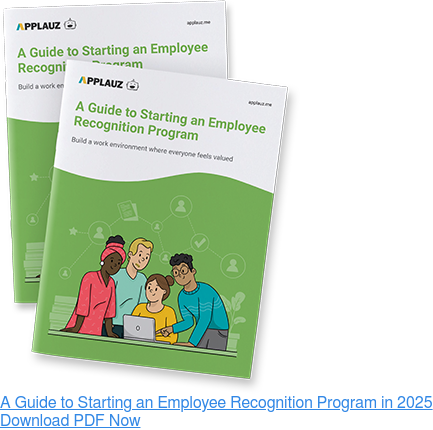Organizations are battling a growing employee engagement crisis. According to recent Gallup data, only 31% of U.S. employees are engaged. Furthermore, 18% of workers are actively disengaged. These numbers have been steadily getting worse since 2023.
Wondering what all of this means in practice? “In short, engaged employees are involved in and enthusiastic about their work and workplace,” according to Gallup. “Actively disengaged employees are disgruntled and disloyal because most of their workplace needs are unmet.”
Feeling valued at work is one of those needs – it's one of the dimensions that Gallup actively looks at when measuring employee engagement levels. This makes employee recognition a powerful tool. Employee recognition studies show a direct link between engagement levels and recognition.
Employee Recognition Statistics You Should Know
As a leader or HR professional, it's important to be aware of employee appreciation statistics that can inform your efforts and strategies – counting on managers to give positive feedback or celebrating work anniversaries alone just won't cut it.
Here are employee recognition statistics and facts to keep on your radar as you strive to build a successful employee recognition program.

Employee Recognition and Engagement
Employee recognition and engagement go hand-in-hand because all human beings have a need for appreciation and acknowledgement. From boosting morale to providing employees with a sense of achievement and increased job satisfaction, recognition creates a positive feedback loop that fosters a healthy workplace culture. As a result, productivity and performance go up.
Employee Recognition and Management
A Harvard Business Review study showed that employees who said their managers were great at showing positive recognition were 40% more engaged than those with managers who didn't show the same level of recognition. They also felt more confident and better informed, went above and beyond in their jobs more often, and were less likely to quit.
According to Glassdoor's Employee Appreciation Survey, over half (53%) of employees revealed that they would stay longer at their organization if they felt more appreciation from their boss.
Employee Recognition and Motivation
A staggering 81% of workers reported feeling motivated to work harder when their manager showed appreciation for their efforts.
FlexJobs survey results mirror this finding: 86% of workers admitted that recognition in the workplace is a major driver of motivation.
Also, researchers at Oxford University's Saïd Business School discovered that 92% of employees are more likely to repeat their task after receiving recognition for it.
Influence on Employee Performance
This sense of increased motivation pays off in terms of performance. A Josh Bersin study found that companies with a “recognition-rich culture” vastly outperform others, yet only 17% of respondents fit into this category.
Furthermore, an employee engagement survey conducted by Aberdeen Insights revealed that 67% of best-in-class companies have established formal recognition programs.
Companies Lack Employee Recognition Tools
That said, there's work to be done in terms of implementing effective recognition programs at work. According to Zippia, 29% of employees haven't received recognition for good work in over a year, if at all.
PossibleWorks also reports that only 22% of managers say that they are equipped to understand how to recognize their employees.
These stats point to gaps to bridge – organizations need to implement systems and processes to make sure that employees get recognized regularly and that their bosses have the tools to deliver recognition.
The Cost of Employee Turnover
Recognition also greatly impacts employee retention and lowers turnover rate, which can save organizations huge amounts of money. Replacing employees is expensive in many ways. Not only does it involve new talent acquisition and training, but it can also reduce the morale of existing workers and affect productivity indirectly.
According to Simply Benefits, the cost to replace an entry-level employee turnover is between 30 and 50% of their annual salary, a mid-level employee turnover costs over 150% of their annual salary to replace, and a high-level or highly specialized employee costs about 400% of their annual salary to replace.
Recognizing Employees Prevents Resignations
TINY pulse data shows that recognition has a direct impact on resignation: 21.5% of employees who don't feel recognized when they deliver great work have interviewed for a job in the last three months.
In contrast, only 12.4% of the people who feel recognized have interviewed for a job in the same time period.
Additionally, Gallup reports that employees who are consistently acknowledged by their managers are five times more likely to stay at their organization.
Findings from an Indeed survey showed that 30% of people who quit their job within the first six months would have actually stuck around longer if their contributions were recognized more.
In other words, recognition has a direct impact on employee retention.
Employee Recognition and DEI
Diversity, Equity and Inclusion (DEI) is becoming a top priority in the workplace. Not only is it important when it comes to creating healthy cultures and dismantling toxic ones, but research shows that companies that prioritize diversity outperform competitors.
For example, 60% of respondents in a LinkedIn study reported that diversity within their sales team contributed to the teams' success.
Also, the Diversity and Inclusion (D&I) Global Market Report 2022 revealed that diverse companies earn 2.5 times higher cash flow per employee while inclusive teams are 35% more productive.
An Employee Recognition Program Can Reinforce DEI Efforts
Wondering what this has to do with employee recognition? Gallup research shows that authentic recognition is a powerful tool for reinforcing DEI efforts. When appreciation is genuine and personalized, people feel like they belong, especially BIPOC employees and women, who often get less praise for their work due to unconscious biases in the workplace.
Meaningful Recognition Strengthens Company Culture
Consider this: three-quarters of Black and Hispanic employees do not strongly agree that the recognition they receive is authentic.
Additionally, women are 63% less likely to experience burnout if they strongly agree that they're getting the right amount of recognition for their contributions.
Ageism in the workplace is also a concern. According to Resume Now, 90% of U.S.-based workers aged 40 or older have experienced it, and 44% reported depression as a result of age-related bias.
Inclusive employee appreciation strategies are therefore crucial to cultivating a diverse workforce.
Given the fact that LinkedIn reports that 76% of employees and job seekers said diversity was important when considering job offers, and 80% of survey respondents said they want to work for a company that values DEI issues, this isn't information to dismiss.
Employee Recognition and Remote Work
Remote work is another factor to consider when shaping employee recognition approaches. First, the ability to work remotely is a form of employee appreciation that is highly valued by workers.
Rewarding Employees with Flexibility
An Owl Labs report revealed that 66% of workers would look for a new job if their flexibility to work remotely was taken away, and another 33% would quit.
According to Zapier's The Future of Remote Work Report, 91% of employees say that remote work contributes to their happiness at work. In other words, if you want to show people that you appreciate them, give them flexibility.
Recognizing Remote and Hybrid Workers
Additionally, it's critical to recognize remote and hybrid workers fairly. A recent study conducted by the SHRM showed that 42% of respondents sometimes forget about remote workers when assigning tasks. It's easy to overlook remote workers when dishing out praise too – and this bias is a blind spot to be aware of.
It's especially concerning when it comes to working mothers. Recent research revealed that 43%of mothers who work remotely feel overlooked for promotion and advancement opportunities.
According to Indeed, 37% of remote workers are worried about getting less interaction with, access to, and acknowledgement from higher management.
Moreover, remote workers are more likely to suffer from the effects of not being trusted. A report from ExpressVPN showed that 78% of bosses engage in remote workforce surveillance, which has a negative impact on employees' mental state.
In light of this information, leaders should keep remote team engagement in mind when creating employee recognition programs.
Other Employee Recognition Statistics and Facts
It's worth noting that not all types of recognition are created equal. Up to 55% of employee engagement is driven by non-financial recognition, revealed McKinsey data.
“Currently, many tactics meant to bring employees together are received as the opposite—transactional, commonplace, and impersonal. For example, the “mass market” approach of giving everyone a one-time bonus might seem noble and effective at a surface level but runs the risk of hitting all the wrong notes,” according to McKinsey.
To avoid this trap, McKinsey recommends that leaders determine what matters most to their people so that they can personalize their expressions of recognition and appreciation.
The Most Memorable Recognition Comes from the Top
Interestingly, the most memorable form of recognition comes from senior leadership, suggests a Gallup workplace survey that had workers reflecting on who gave them their most meaningful and memorable recognition. The top answers were recognition coming from an employee's manager (28%) or from a high-level leader or CEO (24%).
But Peer-to-Peer Recognition Is Also Important
While recognition from the C-Suite makes a big impact on employee satisfaction, peer recognition should also be part of your employee recognition program. According to Gartner, peer feedback can enhance performance by as much as 14%.
A SHRM/Globoforce survey also revealed that companies that promote peer-to-peer recognition are 35.7% more likely to see a positive impact on financial results.
Additionally, 57% have experienced increased engagement, 41% saw an increase in customer satisfaction, 32% saw an increase in customer retention, 32% enjoyed boosts in productivity and 28% saw benefits in terms of employee retention.
Frequent Recognition Is Crucial
The frequency of recognition matters too. To create a “recognition-rich culture,” Gallup suggests giving praise every seven days. “The criteria for recognition should align with the purpose, brand and culture of the company and should reflect its aspirational identity to inspire others,” notes Gallup.
The Four Types of Employee Recognition
According to BambooHR, there are four main types of recognition:
-
Public recognition, such as awards;
-
Private recognition, such as praise from a boss, peer or customer;
-
Promotions;
-
Monetary or tangible awards, such as a trip, bonus or pay increase.
Ultimately, different people respond to different types of recognition based on their unique preferences and values. Leaders should aim to build comprehensive recognition programs that cover different bases for the best results.
Recognizing Employees from Different Generations
There are also generational differences to consider. Millennials now make up the largest share of the workforce. But, according to Gallup, only about one in three of them are engaged at work. In fact, the majority of millennials (55%) are not engaged.
Tying recognition to employee rewards focused on work-life balance is a powerful way to combat that trend. Research revealed that millennials value work-life balance much more than older generations, rating its importance at nearly a 9 out of 10 (8.69).
Meanwhile, Gen Z is all about learning. According to Udemy, a staggering 94% of Gen Zers spend at least an hour a week developing their skills. They also love to do it through online courses (44% of respondents cited that method as a preferred way to learn). Recognize younger workers by offering them the chance to upskill and watch engagement soar.
Leverage Technology to Maximize Recognition Efforts
While management and HR research is always evolving, one thing's for sure: Recognition will continue to play a pivotal role in employee engagement trends for decades to come.
If you want to build a robust company culture and get a leg up on your competition, a platform like Applauz can help you create a successful employee recognition program.
About the author
Anouare Abdou
Anouare Abdou is a seasoned HR and business writer passionate about leadership, productivity, and the future of work. Her words have appeared in Business Insider, The Ladders, Thrive Global and more.



